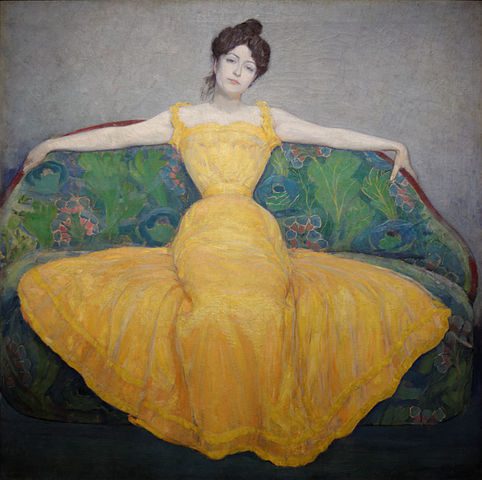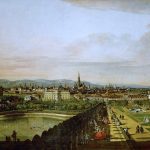
The Vienna Secession marked a turning point in art history, rejecting tradition in favor of bold innovation. This revolutionary movement emerged in the late 19th century in Vienna, Austria, during a time when cultural and societal norms were being challenged across Europe. The Secessionists sought to create an artistic platform that transcended the rigidity of academic art, embracing individuality and modernism. This article explores the origins, philosophy, key contributors, and enduring legacy of this groundbreaking art movement.
Introduction to the Vienna Secession
The Vienna Secession was founded in 1897 as a response to the conservative grip of the Vienna Academy of Fine Arts. At the time, Vienna was a thriving cultural hub, but its artistic landscape was dominated by rigid academic standards. The Secessionists sought to break free from these constraints and establish a new artistic vision. This was not just a rejection of tradition but an embrace of global modernism, aligning with movements like Art Nouveau and Symbolism.
Led by Gustav Klimt, the group included painters, architects, and designers such as Koloman Moser and Josef Hoffmann. These artists believed in creating art for a modern age, expressing individuality while addressing the evolving tastes of society. Their work emphasized freedom, rejecting uniformity and celebrating diversity in artistic expression. Through exhibitions and publications, the Vienna Secession brought their radical ideas to life, captivating audiences and inspiring future movements.
The movement’s motto, “To every age its art, to art its freedom,” encapsulated their mission. This declaration challenged the notion that art must adhere to outdated principles, advocating instead for relevance and innovation. By promoting diverse artistic styles, the Secessionists opened the door to a new era of creativity that influenced art and design globally.
In its essence, the Vienna Secession was more than an art movement—it was a cultural revolution. By challenging conventions and redefining aesthetics, the Secessionists created a legacy that continues to resonate today. Their influence extended beyond Vienna, shaping the future of art, architecture, and design across the world.
Origins and Founding of the Vienna Secession
The Vienna Secession was officially founded in 1897 when a group of Austrian artists broke away from the Vienna Academy of Fine Arts. This collective action was spearheaded by Gustav Klimt, a prominent painter dissatisfied with the Academy’s conservative policies. Klimt, along with architects Josef Hoffmann and Joseph Maria Olbrich, as well as designer Koloman Moser, sought to create a space where modern ideas could flourish. Their decision to secede reflected their commitment to progress and individuality.
This movement arose during a time of significant change in Europe, as industrialization and urbanization transformed society. The Secessionists were influenced by international trends such as Impressionism and Art Nouveau, incorporating these styles into their work while maintaining a distinctly Austrian character. Their shared dissatisfaction with the limitations imposed by traditional art institutions united them in their pursuit of innovation.
Personal relationships and collaborations played a crucial role in the founding of the Vienna Secession. Klimt’s leadership inspired his peers, while Moser and Hoffmann brought their expertise in design and architecture to the movement. Together, they created a multidisciplinary approach that blended painting, sculpture, graphic design, and decorative arts. This holistic vision set the Vienna Secession apart from other movements of its time.
The group’s formation was a bold act of defiance against the status quo. By establishing their own association, the Secessionists declared their independence from the Academy and its rigid standards. This decision not only redefined the role of the artist in society but also laid the groundwork for a modern approach to art and design.
Artistic Philosophy and Aesthetic Innovations
At the heart of the Vienna Secession was the belief that art should be free from societal constraints. Their motto, “To every age its art, to art its freedom,” underscored their commitment to individuality and progress. This philosophy rejected the uniformity of academic art, emphasizing instead the diversity of artistic expression. The Secessionists sought to create works that reflected the spirit of their time while remaining timeless in their appeal.
The Secessionist style was characterized by its innovative use of form, color, and symbolism. Influenced by Art Nouveau, the movement incorporated organic shapes, flowing lines, and intricate patterns into its designs. This aesthetic was not confined to painting but extended to architecture, graphic design, and decorative arts, creating a cohesive visual language. The Secessionists embraced abstraction and symbolism, often exploring themes of nature, emotion, and the human experience.
International influences played a significant role in shaping the artistic philosophy of the Vienna Secession. The group drew inspiration from movements such as Impressionism, Symbolism, and Japanese art, integrating these elements into their work. This global perspective allowed the Secessionists to transcend national boundaries and contribute to the development of modern art on a broader scale.
The Vienna Secession was not only a movement but also a platform for experimentation and innovation. Through their exhibitions, the artists challenged audiences to reconsider their perceptions of art and design. By prioritizing creativity and individuality, the Secessionists paved the way for future movements that would continue to push the boundaries of artistic expression.
The Role of the Secession Building
The Secession Building, completed in 1898, served as the physical and symbolic center of the Vienna Secession. Designed by Joseph Maria Olbrich, the building embodied the group’s philosophy of modernity and innovation. Its striking architecture, featuring a dome of golden laurel leaves, became an iconic representation of the movement. The building’s inscription, “To every age its art, to art its freedom,” reinforced the Secessionists’ commitment to progress.
The Secession Building was more than a gallery; it was a space for dialogue and experimentation. The artists used it to showcase their work and promote their ideals, hosting exhibitions that challenged traditional notions of art. One of the most famous exhibitions was the 1902 Beethoven Exhibition, which featured Gustav Klimt’s Beethoven Frieze. This monumental work celebrated the intersection of music and art, capturing the spirit of the Secession.
The building’s innovative design reflected the Secessionists’ belief in the unity of art and architecture. Olbrich’s use of geometric forms and minimalist ornamentation broke away from traditional architectural styles. The interior spaces were designed to complement the artworks on display, creating a harmonious environment that enhanced the viewer’s experience.
Today, the Secession Building remains a testament to the vision and creativity of its founders. It continues to host exhibitions and serves as a reminder of the revolutionary spirit that defined the Vienna Secession. As both a historic landmark and a cultural institution, the building embodies the enduring legacy of this groundbreaking movement.
Key Artists and Their Contributions
Gustav Klimt, one of the founding members, was the most prominent figure of the Vienna Secession. Known for his iconic works such as The Kiss and Beethoven Frieze, Klimt’s art epitomized the movement’s ideals. His use of gold leaf, intricate patterns, and symbolic imagery created a distinctive style that continues to captivate audiences. Klimt’s leadership and vision were instrumental in shaping the direction of the Secession.
Koloman Moser was another key contributor, known for his versatility as a designer. His work spanned graphic design, furniture, and textiles, reflecting the movement’s interdisciplinary approach. Moser co-founded the Wiener Werkstätte with Josef Hoffmann, a collective that further advanced the Secessionists’ ideals. His designs emphasized functionality and beauty, bridging the gap between fine art and applied arts.
Josef Hoffmann was a pioneering architect who played a crucial role in the Vienna Secession. His architectural designs, characterized by clean lines and geometric forms, influenced modernist architecture. Hoffmann’s collaboration with Moser in the Wiener Werkstätte produced some of the most iconic designs of the era. His work demonstrated the movement’s commitment to integrating art into everyday life.
Later contributors such as Egon Schiele and Oskar Kokoschka carried forward the legacy of the Vienna Secession. Their work, characterized by emotional intensity and innovative techniques, reflected the movement’s emphasis on individuality and experimentation. These artists built upon the foundations laid by Klimt and his contemporaries, ensuring the continued relevance of Secessionist ideals.
Legacy and Influence of the Vienna Secession
The Vienna Secession had a profound impact on the development of modern art, architecture, and design. Its emphasis on individuality and innovation inspired subsequent movements such as Art Deco and Modernism. The Secessionists’ commitment to integrating art into all aspects of life influenced the Bauhaus and other design schools. Their holistic approach to art and design remains a guiding principle for contemporary creators.
The movement’s influence extended far beyond Austria, reaching international audiences through exhibitions and publications. The Secessionists’ works were widely reproduced, allowing their ideas to spread across Europe and beyond. This global reach cemented the Vienna Secession’s place in art history as a pioneering force in modernism.
Today, the legacy of the Vienna Secession can be seen in the continued relevance of its ideals. The movement’s commitment to freedom, creativity, and innovation resonates with contemporary artists and designers. Landmarks such as the Secession Building serve as reminders of the group’s revolutionary spirit and enduring impact.
The Vienna Secession remains a symbol of artistic progress and cultural transformation. By challenging conventions and embracing modernity, the Secessionists paved the way for new forms of expression. Their work continues to inspire and influence, ensuring that their vision lives on in the art and design of the future.
Conclusion: The Enduring Spirit of Secession
The Vienna Secession was more than an art movement; it was a cultural revolution that redefined the role of art in society. By breaking away from tradition and embracing modernism, the Secessionists created a legacy that continues to resonate today. Their commitment to individuality, innovation, and collaboration set a new standard for artistic expression.
As a group, the Secessionists demonstrated the power of collective vision and the importance of challenging the status quo. Their work, from the iconic paintings of Gustav Klimt to the architectural achievements of Josef Hoffmann, reflected a commitment to excellence and progress. Through their exhibitions and publications, they brought their ideas to a global audience, inspiring future generations.
The spirit of the Vienna Secession lives on in contemporary art and design. Its emphasis on freedom and creativity remains a guiding principle for artists seeking to push boundaries and redefine conventions. The movement’s legacy serves as a reminder of the transformative power of art.
In exploring the Vienna Secession, we uncover not only the history of a remarkable movement but also the enduring relevance of its ideals. The Secessionists’ vision continues to inspire, inviting us to imagine new possibilities for art and design.
Key Takeaways
- The Vienna Secession was founded in 1897 to challenge traditional academic art.
- Gustav Klimt, Koloman Moser, and Josef Hoffmann were key figures in the movement.
- The Secession Building became a symbol of the group’s philosophy and innovation.
- The movement influenced global art and design, inspiring future modernist movements.
- The Vienna Secession’s legacy endures through its emphasis on individuality and creativity.
FAQs
1. What was the Vienna Secession?
The Vienna Secession was an art movement founded in 1897 in Vienna, Austria, by artists seeking to break away from traditional academic art.
2. Who were the key figures of the Vienna Secession?
Notable figures included Gustav Klimt, Koloman Moser, Josef Hoffmann, and Joseph Maria Olbrich.
3. What was the significance of the Secession Building?
The Secession Building symbolized the group’s philosophy and served as a gallery for innovative exhibitions.
4. How did the Vienna Secession influence future art movements?
It inspired movements like Art Deco and Modernism and influenced design schools such as the Bauhaus.
5. What is the legacy of the Vienna Secession today?
The movement’s emphasis on individuality and innovation continues to inspire contemporary art and design.




